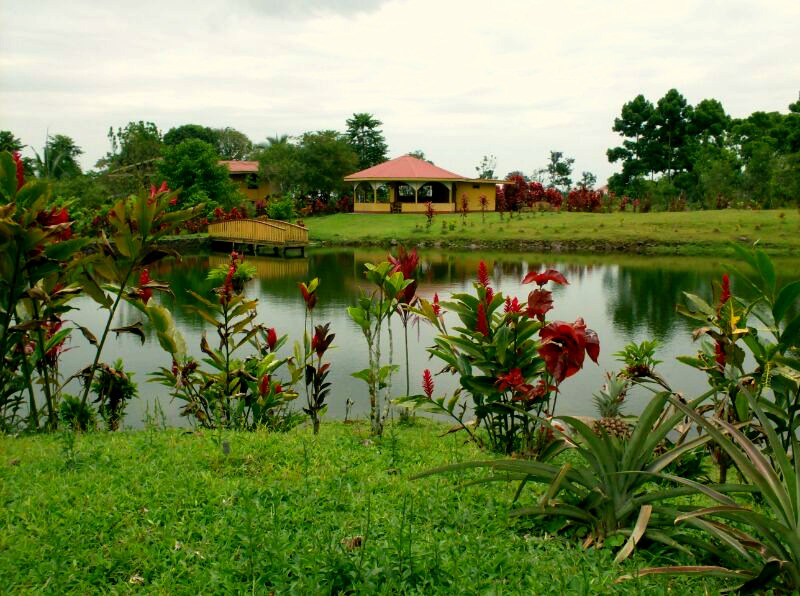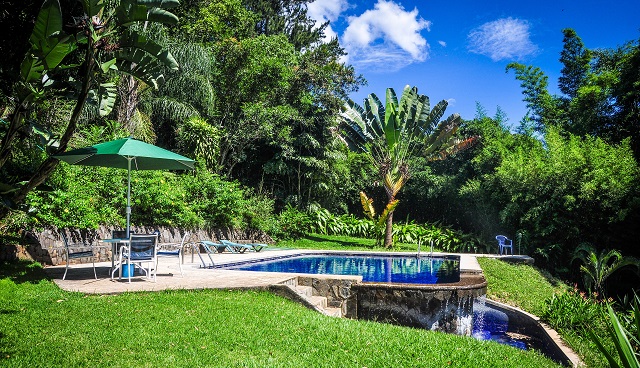Costa Rica News – A luxury eco-resort and a small family farm share roots in Puerto Jimenez, Costa Rica. Driving down the oft-rutted roads of this largest city on Costa Rica’s Oza Peninsula, it would be easy to miss the small hand-painted metal sign that indicates the turnoff to the Raices Rancho.
 “Welcome,” it says in bold red letters, “to Raices Rancho Tours. A family in harmony with the environment. We conserve our cultural traditions and protect our ecology. We eat what our land gives us.”
“Welcome,” it says in bold red letters, “to Raices Rancho Tours. A family in harmony with the environment. We conserve our cultural traditions and protect our ecology. We eat what our land gives us.”
From that description you might expect a state-of-the-art modern enterprise that incorporates all the latest innovations in farming, recycling and sustainability. What you encounter is a gracious multigenerational family farm that is distinctly modern in its outlook, but whose lifestyle and organic farming practices reflect a way people have lived on the land of Costa Rica for centuries.
As we pull up the gravel drive that leads to the family’s modest home, spattered in mud from a recent rain, Don German Quiroz and his daughter, Vanessa, are waiting to greet us. Then an adventure of surprising dimension begins.
Setting off in single file we follow Quiroz down a trail that leads from the house to the farm itself. Like Dorothy, we are definitely not in Kansas anymore! Nurtured by bountiful rainfall, this is a farm that exists in complement with a jungle where monkeys leap from tree to tree, lavishly colored butterflies glide and the colors of flowers are as bright as neon signs.
“We grow a wide variety of crops,” Quiroz explains.
There are spiky white pineapples, bulbous mangos, shafts of sugarcane, brightly colored papayas and emerald-green bunches of bananas and plantains. There’s even a talapia pond. But the crop for which the family is best known, especially to its visitors, is the cocoa plants from which they make the most wonderful home-grown and hand-ground chocolate.
After following the muddy trail, which is overhung with creeping vines and towering trees (some more than 300 years old), we come to a two-story house made from shafts of lashed-together bamboo and palm thatch. The lower area with its packed dirt floor is used for dining and cooking, much of it on an open charcoal fire.
As we arrive, Quiroz’s wife, Rosemary, is preparing breakfast for us. There are home-raised scrambled eggs, brown beans and rice, roasted bananas and freshly made white cheese, all served on a banana leaf and accompanied by steaming hot Costa Rican coffee.
It may be a tour, but it feels like a family gathering as our meal is observed by a diverse assortment of various sizes of dogs, chickens, geese and turkeys that wander about clucking, gobbling, honking and barking. And although this is Costa Rica and not Tahiti, there is the sense that we have all been magically transported into a painting by Gauguin.
As the rain begins to fall we are given a demonstration of chocolate-making. First the roasted beans are sorted. Then the husks are separated using an age-old flipping technique and a wicker basket as the chickens fight over the droppings. Then the hand-grinding process begins. Again and again the beans are fed through the hand-grinder until the result is a rich dark-brown paste. Tastes are offered throughout the process. At first the rough beans are crunchy, toward bitter. But as the grinding progresses the rich, deep, earthy flavor of the chocolate emerges in all its glory.
When the rain starts pelting down Quiroz hacks off large banana leaves with his machete and offers them to each of us as a Costa Rican umbrella. Finally, back at the house, fond partings and thanks are exchanged for what has been a truly wonderful experience — muchas gracias!
About an hour away from the Raices Rancho, high on a mountaintop overlooking the sea, is a very different destination — Lapa Rios, which has been designated one of National Geographic’s Unique Lodges of the World.
This is sustainability with a five-star rating where guests pay as much as $500 a day to stay in luxurious bedroom suites that are built harmoniously into the mountainside. There are not too many places where you can enjoy this level of comfort as luminescent toucans and macaws sail through the trees and you wake to the screech of howler monkeys.
Set in a private nature reserve spread over 1,000 acres of Central America’s last remaining lowland tropical rainforest, Lapa Rios is a wonderland adventure of the first order. The lodge features 17 private bungalows nestled in the trees overlooking the point of land where the Golfo Dulce meets the Pacific Ocean. The towering lobby is made from locally harvested materials, and much like the Raises Rancho, Lapa Rios emphasizes sustainability, farm-to-table fresh ingredients and a deeply embedded sense of eco-consciousness.
You can hike through the jungle to a waterfall or learn about the multitude of medicinal uses the indigenous plants provide — from cures for headaches and stomachaches to a form of natural talcum powder. Watch leafcutter ants build their vast colonies and perhaps you might spot a sloth, a tapir or a puma.
While Lapa Rios offers a wide variety of activities, along with three excellently prepared meals a day, the resort is equally attractive as a location for those who seek inner wellness. There are yoga and meditation classes, a beautiful pool and an open-air massage bungalow. It is hard to describe the sensation of a tantric massage melting away every bit of tension as your senses are lulled by the sound of the distant surf and the soft caress of the wind.
If there is one element that links the luxury of Lapa Rios and the humble graciousness of the Raices Rancho it the connection both places feel with the land and the joy they take in sharing its bounty.
By Jim Farber, Creators.com

